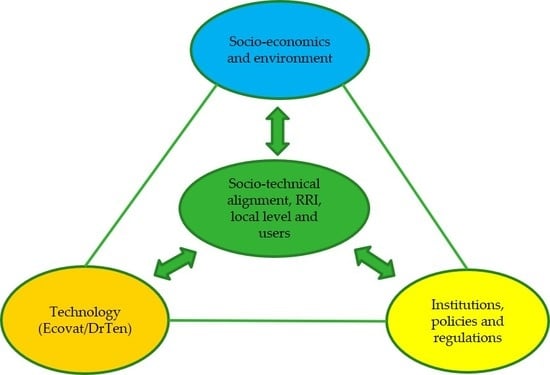Innovation Dynamics of Socio-Technical Alignment in Community Energy Storage: The Cases of DrTen and Ecovat
Abstract
1. Introduction
2. Conceptual Research Framework
3. Research Design and Methods
4. Emerging Energy Storage Technologies: The Cases of DrTen® and Ecovat®
4.1. Key Characteristics
4.2. Key Processes in Innovation Dynamics
4.3. Actor Analysis
4.4. Use Cases in Local Communities
4.5. Socio-Technical Alignment Dynamics
5. Conclusions and Discussion
Author Contributions
Funding
Acknowledgments
Conflicts of Interest
References
- Kelly, S.; Pollitt, M.G. The local dimension of energy. In The Future of Electricity Demand: Customers, Citizens and Loads; Pollitt, M.G., Ed.; Cambridge University Press: Cambridge, UK, 2011; pp. 249–275. [Google Scholar]
- Vargas, M.; Davis, G. World Energy Scenarios 2016; World Energy Council: London, UK, 2016. [Google Scholar]
- Koirala, B.P.; Koliou, E.; Friege, J.; Hakvoort, R.A.; Herder, P.M. Energetic communities for community energy: A review of key issues and trends shaping integrated community energy systems. Renew. Sustain. Energy Rev. 2016, 56, 722–744. [Google Scholar] [CrossRef]
- Devine-Wright, P. Community versus local energy in a context of climate emergency. Nat. Energy 2019, 4, 894–896. [Google Scholar] [CrossRef]
- Koirala, B.P.; van Oost, E.; van der Windt, H. Community energy storage: A responsible innovation towards a sustainable energy system? Appl. Energy 2018, 231, 570–585. [Google Scholar] [CrossRef]
- Kyriakopoulos, G.L.; Arabatzis, G. Electrical energy storage systems in electricity generation: Energy policies, innovative technologies, and regulatory regimes. Renew. Sustain. Energy Rev. 2016, 56, 1044–1067. [Google Scholar] [CrossRef]
- Manfren, M.; Caputo, P.; Costa, G. Paradigm shift in urban energy systems through distributed generation: Methods and models. Appl. Energy 2011, 88, 1032–1048. [Google Scholar] [CrossRef]
- Koirala, B.P.; Araghi, Y.; Kroesen, M.; Ghorbani, A.; Hakvoort, R.A.; Herder, P.M. Trust, awareness, and independence: Insights from a socio-psychological factor analysis of citizen knowledge and participation in community energy systems. Energy Res. Soc. Sci. 2018, 38, 33–40. [Google Scholar] [CrossRef]
- Kalkbrenner, B.J.; Roosen, J. Citizens’ willingness to participate in local renewable energy projects: The role of community and trust in Germany. Energy Res. Soc. Sci. 2016, 13, 60–70. [Google Scholar] [CrossRef]
- Van der Waal, E.C.; Das, A.M.; van der Schoor, T. Participatory Experimentation with Energy Law: Digging in a ‘Regulatory Sandbox’ for Local Energy Initiatives in the Netherlands. Energies 2020, 13, 458. [Google Scholar] [CrossRef]
- Gregg, J.S.; Nyborg, S.; Hansen, M.; Schwanitz, V.J.; Wierling, A.; Zeiss, J.P.; Delvaux, S.; Saenz, V.; Polo-Alvarez, L.; Candelise, C.; et al. Collective Action and Social Innovation in the Energy Sector: A Mobilization Model Perspective. Energies 2020, 13, 651. [Google Scholar] [CrossRef]
- Horstink, L.; Wittmayer, J.M.; Ng, K.; Luz, G.P.; Marín-González, E.; Gährs, S.; Campos, I.; Holstenkamp, L.; Oxenaar, S.; Brown, D. Collective Renewable Energy Prosumers and the Promises of the Energy Union: Taking Stock. Energies 2020, 13, 421. [Google Scholar] [CrossRef]
- Kloppenburg, S.; Smale, R.; Verkade, N. Technologies of Engagement: How Battery Storage Technologies Shape Householder Participation in Energy Transitions. Energies 2019, 12, 4384. [Google Scholar] [CrossRef]
- Dilger, M.G.; Konter, M.; Voigt, K.-I. Introducing a co-operative-specific business model: The poles of profit and community and their impact on organizational models of energy co-operatives. J. CoOper. Organ. Manag. 2017, 5, 28–38. [Google Scholar] [CrossRef]
- EU Clean Energy for All Europeans—Energy—European Commission. Available online: /energy/en/topics/energy-strategy-and-energy-union/clean-energy-all-europeans (accessed on 24 July 2019).
- Van der Schoor, T.; Scholtens, B. Power to the people: Local community initiatives and the transition to sustainable energy. Renew. Sustain. Energy Rev. 2015, 43, 666–675. [Google Scholar] [CrossRef]
- Lowitzsch, J. Consumer Stock Ownership Plans (CSOPs)—The Prototype Business Model for Renewable Energy Communities. Energies 2019, 13, 118. [Google Scholar] [CrossRef]
- RED II Directive (EU) 2018/2001 of the European Parliament and of the Council of 11 December 2018 on the Promotion of the Use of Energy from Renewable Sources; Publications office of the European Union: Luxembourg, 2018.
- EMD II Directive (EU) 2019/944 of the European Parliament and of the Council of 5 June 2019 on Common Rules for the Internal Market for Electricity and Amending Directive 2012/27/EU; Publications office of the European Union: Luxembourg, 2019.
- Koirala, B.P. Integrated Community Energy Systems. Ph.D. Thesis, Delft University of Technology, Delft, The Netherlands, 2017. [Google Scholar]
- Parra, D.; Swierczynski, M.; Stroe, D.I.; Norman, S.A.; Abdon, A.; Worlitschek, J.; O’Doherty, T.; Rodrigues, L.; Gillott, M.; Zhang, X.; et al. An interdisciplinary review of energy storage for communities: Challenges and perspectives. Renew. Sustain. Energy Rev. 2017, 79, 730–749. [Google Scholar] [CrossRef]
- Koirala, B.P.; van Oost, E.; van der Windt, H. Socio-Technical Innovation Dynamics in Community Energy Storage; CESUN Conference: Tokyo, Japan, 2018; pp. 1–8. [Google Scholar]
- Maclaine Pont, P.; van Est, R.; Deuten, J. Shaping Socio-Technical Innovation through Policy; Rathenau Institute: Den Hague, The Netherlands, 2016. [Google Scholar]
- EnergystorageNL National Actionplan on Energy Storage and Conversion; ESNL: Zoetermeer, The Netherlands, 2019.
- IRENA Renewables and Electricity Storage: A Technology Roadmap for REMAP 2030; International Renewable Energy Agency: Abu Dhabi, UAE, 2015.
- De Torres, P.M.A. An overview on strategic design for socio-technical innovation. Strateg. Des. Res. J. 2018, 11, 186–192. [Google Scholar] [CrossRef]
- Konrad, K.; Böhle, K. Socio-technical futures and the governance of innovation processes—An introduction to the special issue. Futures 2019, 109, 101–107. [Google Scholar] [CrossRef]
- Dong, S.; Kremers, E.; Brucoli, M.; Rothman, R.; Brown, S. Techno-enviro-economic assessment of household and community energy storage in the UK. Energy Convers. Manag. 2020, 205, 112330. [Google Scholar] [CrossRef]
- Koirala, B.P.; van Oost, E. Local Energy Communities: Responsible Innovation Towards Sustainable Energy (CO-RISE). In Proceedings of the CTIT Symposium 2017: IoT is Ready. What about Us; University of Twente: Enschede, The Netherlands, 2017. [Google Scholar]
- Koirala, B.P.; Hakvoort, R.A.; van Oost, E.C.; van der Windt, H.J. Community Energy Storage: Governance and Business Models. In Consumer, Prosumer, Prosumager; Academic Press: Cambridge, MA, USA, 2019; pp. 209–234. ISBN 978-0-12-816835-6. [Google Scholar]
- Garud, R.; Karnøe, P. Bricolage versus breakthrough: Distributed and embedded agency in technology entrepreneurship. Res. Policy 2003, 32, 277–300. [Google Scholar] [CrossRef]
- Ornetzeder, M.; Rohracher, H. User-led innovations and participation processes: Lessons from sustainable energy technologies. Energy Policy 2006, 34, 138–150. [Google Scholar] [CrossRef]
- Ornetzeder, M.; Rohracher, H. Of solar collectors, wind power, and car sharing: Comparing and understanding successful cases of grassroots innovations. Glob. Environ. Chang. 2013, 23, 856–867. [Google Scholar] [CrossRef]
- Seyfang, G.; Park, J.J.; Smith, A. A thousand flowers blooming? An examination of community energy in the UK. Energy Policy 2013, 61, 977–989. [Google Scholar] [CrossRef]
- Bomberg, E.; McEwen, N. Mobilizing community energy. Energy Policy 2012, 51, 435–444. [Google Scholar] [CrossRef]
- Seyfang, G.; Hielscher, S.; Hargreaves, T.; Martiskainen, M.; Smith, A. A grassroots sustainable energy niche? Reflections on community energy in the UK. Environ. Innov. Soc. Transit. 2014, 13, 21–44. [Google Scholar] [CrossRef]
- Hargreaves, T.; Hielscher, S.; Seyfang, G.; Smith, A. Grassroots innovations in community energy: The role of intermediaries in niche development. Glob. Environ. Chang. 2013, 23, 868–880. [Google Scholar] [CrossRef]
- Van der Waal, E.; van der Windt, H.; van Oost, E. How Local Energy Initiatives Develop Technological Innovations: Growing an Actor Network. Sustainability 2018, 10, 4577. [Google Scholar] [CrossRef]
- Verbeek, P.-P. Materializing Morality: Design Ethics and Technological Mediation. Sci. Technol. Hum. Values 2006, 31, 361–380. [Google Scholar] [CrossRef]
- Winner, L. Do artefacts have politics? Daedalus 1980, 109, 121–136. [Google Scholar]
- Owen, R.; Stilgoe, J.; Macnaghten, P.; Gorman, M.; Fisher, E.; Guston, D. A Framework for Responsible Innovation. In Responsible Innovation; Owen, R., Bessant, J., Heintz, M., Eds.; John Wiley & Sons, Ltd.: Chichester, UK, 2013; pp. 27–50. ISBN 978-1-118-55142-4. [Google Scholar]
- Stilgoe, J.; Owen, R.; Macnaghten, P. Developing a framework for responsible innovation. Res. Policy 2013, 42, 1568–1580. [Google Scholar] [CrossRef]
- Timmermans, J. Mapping the RRI Landscape: An Overview of Organisations, Projects, Persons, Areas and Topics. In Responsible Innovation 3; Asveld, L., van Dam-Mieras, R., Swierstra, T., Lavrijssen, S., Linse, K., van den Hoven, J., Eds.; Springer International Publishing: Cham, Switzerland, 2017; pp. 21–47. ISBN 978-3-319-64833-0. [Google Scholar]
- Rogers, J.C.; Simmons, E.A.; Convery, I.; Weatherall, A. Public perceptions of opportunities for community-based renewable energy projects. Energy Policy 2008, 36, 4217–4226. [Google Scholar] [CrossRef]
- Walker, G.; Devine-Wright, P.; Barnett, P.; Burningham, K.; Cass, N.; Devine-Wright, H.; Speller, G.; Barton, J.; Evans, B.; Heath, Y. Symmetries, expectations, dynamics and contexts: A framework for understanding public engagement with renewable energy projects. In Renewable Energy and the Public: From Nimby to Participation; Earthscan; Routledge; Taylor & Francis: London, UK, 2010; pp. 2–14. ISBN 1844078639. [Google Scholar]
- Walker, G. What are the barriers and incentives for community-owned means of energy production and use? Energy Policy 2008, 36, 4401–4405. [Google Scholar] [CrossRef]
- Walker, G.; Devine-Wright, P. Community renewable energy: What should it mean? Energy Policy 2008, 36, 497–500. [Google Scholar] [CrossRef]
- Walker, G.; Simcock, N. Community Energy Systems. Int. Encycl. Hous. HomeElsevier 2012, 1, 194–198. [Google Scholar]
- Wirth, S. Communites matter: Institutional preconditions for community renewable energy. Energy Policy 2014, 1–11. [Google Scholar]
- Koirala, B.; Chaves Ávila, J.; Gómez, T.; Hakvoort, R.; Herder, P. Local Alternative for Energy Supply: Performance Assessment of Integrated Community Energy Systems. Energies 2016, 9, 981. [Google Scholar] [CrossRef]
- Koirala, B.; Hakvoort, R. Integrated Community-Based Energy Systems: Aligning Technology, Incentives, and Regulations. In Innovation and Disruption at the Grid’s Edge; Academic Press: Cambridge, MA, USA, 2017; pp. 363–387. ISBN 978-0-12-811758-3. [Google Scholar]
- Koirala, B.P.; Hakvoort, R.A.; Ávila, J.P.C.; Gómez, T. Assessment of Integrated Community Energy Systems. In Proceedings of the 2016 13th International Conference on the European Energy Market (EEM), Porto, Portugal, 6–9 June 2016; pp. 1–6. [Google Scholar]
- Acosta, C.; Ortega, M.; Bunsen, T.; Koirala, B.; Ghorbani, A. Facilitating Energy Transition through Energy Commons: An Application of Socio-Ecological Systems Framework for Integrated Community Energy Systems. Sustainability 2018, 10, 366. [Google Scholar] [CrossRef]
- Caramizaru, A.; Uihlein, A.; European Commission; Joint Research Centre. Energy Communities: An Overview of Energy and Social Innovation; Publications Office of the European Union: Luxembourg, 2020; ISBN 978-92-76-10713-2. [Google Scholar]
- Van der Schoor, T.; Scholtens, B. Scientific Approaches of Community Energy: A Literature Review; Centre for Energy Economics Research (CEER): Groningen, The Netherlands, 2019; ISBN 978-94-034-1657-1. [Google Scholar]
- Van der Schoor, T.; van Lente, H.; Scholtens, B.; Peine, A. Challenging obduracy: How local communities transform the energy system. Energy Res. Soc. Sci. 2016, 13, 94–105. [Google Scholar] [CrossRef]
- Mendes, G.; Ioakimidis, C.; Ferrão, P. On the planning and analysis of Integrated Community Energy Systems: A review and survey of available tools. Renew. Sustain. Energy Rev. 2011, 15, 4836–4854. [Google Scholar] [CrossRef]
- Romero-Rubio, C.; de Andrés Díaz, J.R. Sustainable energy communities: A study contrasting Spain and Germany. Energy Policy 2015, 85, 397–409. [Google Scholar] [CrossRef]
- De Vries, G.W.; Boon, W.P.C.; Peine, A. User-led innovation in civic energy communities. Environ. Innov. Soc. Transit. 2016, 19, 51–65. [Google Scholar] [CrossRef]
- Moroni, S.; Alberti, V.; Antoniucci, V.; Bisello, A. Energy Communities in a Distributed-Energy Scenario: Four Different Kinds of Community Arrangements. In Smart and Sustainable Planning for Cities and Regions; Bisello, A., Vettorato, D., Laconte, P., Costa, S., Eds.; Springer International Publishing: Cham, Switzerland, 2018; pp. 429–437. ISBN 978-3-319-75773-5. [Google Scholar]
- Gui, E.M.; MacGill, I. Typology of future clean energy communities: An exploratory structure, opportunities, and challenges. Energy Res. Soc. Sci. 2018, 35, 94–107. [Google Scholar] [CrossRef]
- Espe, E.; Potdar, V.; Chang, E. Prosumer Communities and Relationships in Smart Grids: A Literature Review, Evolution and Future Directions. Energies 2018, 11, 2528. [Google Scholar] [CrossRef]
- Barbour, E.; Parra, D.; Awwad, Z.; González, M.C. Community energy storage: A smart choice for the smart grid? Appl. Energy 2018, 212, 489–497. [Google Scholar] [CrossRef]
- Van der Stelt, S.; AlSkaif, T.; van Sark, W. Techno-economic analysis of household and community energy storage for residential prosumers with smart appliances. Appl. Energy 2018, 209, 266–276. [Google Scholar] [CrossRef]
- Roberts, B.P.; Sandberg, C. The Role of Energy Storage in Development of Smart Grids. Proc. IEEE 2011, 99, 1139–1144. [Google Scholar] [CrossRef]
- Jolivet, E.; Heiskanen, E. Blowing against the wind—An exploratory application of actor network theory to the analysis of local controversies and participation processes in wind energy. Energy Policy 2010, 38, 6746–6754. [Google Scholar] [CrossRef]
- Hargreaves, T. Practice-ing behaviour change: Applying social practice theory to pro-environmental behaviour change. J. Consum. Cult. 2011, 11, 79–99. [Google Scholar] [CrossRef]
- Aune, M.; Godbolt, Å.L.; Sørensen, K.H.; Ryghaug, M.; Karlstrøm, H.; Næss, R. Concerned consumption. Global warming changing household domestication of energy. Energy Policy 2016, 98, 290–297. [Google Scholar] [CrossRef]
- Devine-Wright, P.; Batel, S.; Aas, O.; Sovacool, B.; Labelle, M.C.; Ruud, A. A conceptual framework for understanding the social acceptance of energy infrastructure: Insights from energy storage. Energy Policy 2017, 107, 27–31. [Google Scholar] [CrossRef]
- Jalas, M.; Hyysalo, S.; Heiskanen, E.; Lovio, R.; Nissinen, A.; Mattinen, M.; Rinkinen, J.; Juntunen, J.K.; Tainio, P.; Nissilä, H. Everyday experimentation in energy transition: A practice-theoretical view. J. Clean. Prod. 2017, 169, 77–84. [Google Scholar] [CrossRef]
- Ryghaug, M.; Toftaker, M. A Transformative Practice? Meaning, Competence, and Material Aspects of Driving Electric Cars in Norway. Nat. Cult. 2014, 9, 146–163. [Google Scholar] [CrossRef]
- Geels, F.W.; Schot, J. Typology of sociotechnical transition pathways. Res. Policy 2007, 36, 399–417. [Google Scholar] [CrossRef]
- Geels, F.W. Ontologies, socio-technical transitions (to sustainability), and the multi-level perspective. Res. Policy 2010, 39, 495–510. [Google Scholar] [CrossRef]
- Markard, J.; Hekkert, M.; Jacobsson, S. The technological innovation systems framework: Response to six criticisms. Environ. Innov. Soc. Transit. 2015, 16, 76–86. [Google Scholar] [CrossRef]
- Schot, J.; Geels, F.W. Strategic niche management and sustainable innovation journeys: Theory, findings, research agenda, and policy. Technol. Anal. Strateg. Manag. 2008, 20, 537–554. [Google Scholar] [CrossRef]
- Von Schomberg, R. A Vision of Responsible Research and Innovation. In Responsible Innovation; Owen, R., Bessant, J., Heintz, M., Eds.; John Wiley & Sons, Ltd.: Chichester, UK, 2013; pp. 51–74. ISBN 978-1-118-55142-4. [Google Scholar]
- Schot, J. Constructive Technology Assessment. Available online: https://www.encyclopedia.com/science/encyclopedias-almanacs-transcripts-and-maps/constructive-technology-assessment (accessed on 28 February 2019).
- De Hoop, E.; Pols, A.; Romijn, H. Limits to responsible innovation. J. Responsible Innov. 2016, 3, 110–134. [Google Scholar] [CrossRef]
- Akrich, M. The de-scription of technical objects. In Shaping Technology/Building Society: Studies in Sociotechnical Change; Bijker, W.E., Law, J., Eds.; The MIT Press: Cambridge, MA, USA; London, UK, 1992; pp. 205–224. [Google Scholar]
- Crettenand, N.; Finger, M. The Alignment between Institutions and Technology in Network Industries. Compet. Regul. Netw. Ind. 2013, 14, 106–129. [Google Scholar] [CrossRef]
- Bauwens, T. Socio-Technical Lock-in and the Alignment Framework: The Case of Distributed Generation Technologies. Compet. Regul. Netw. Ind. 2015, 16, 155–181. [Google Scholar] [CrossRef]
- Bowman, D.M.; Stokes, E.; Rip, A. (Eds.) Embedding New Technologies into Society: A Regulatory, Ethical and Societal Perspective; Pan Stanford Publishing: Singapore, 2017; ISBN 978-981-4745-74-1. [Google Scholar]
- Schot, J.; Rip, A. The past and future of constructive technology assessment. Technol. Forecast. Soc. Chang. 1997, 54, 251–268. [Google Scholar] [CrossRef]
- Unruh, G.C. Escaping carbon lock-in. Energy Policy 2002, 30, 317–325. [Google Scholar] [CrossRef]
- Yin, R.K. Case Study Research: Design and Methods, 5th ed.; SAGE: Los Angeles, CA, USA, 2014; ISBN 978-1-4522-4256-9. [Google Scholar]
- CTA-Toolbox CTA Toolbox. Available online: https://cta-toolbox.nl/ (accessed on 2 December 2019).
- DrTen Seasalt Battery. Available online: http://www.drten.nl/zeezout-batterij/?lang=en (accessed on 26 July 2017).
- Ecovat Ecovat®. Available online: http://www.ecovat.eu/?lang=en (accessed on 4 July 2017).
- Gridflex GridFlex. 2018. Available online: http://gridflex.nl/ (accessed on 8 June 2020).
- WOW District Heating Co-Operative in East Wageningen. Available online: https://cooperatiewow.nl/ (accessed on 2 December 2019).
- De Goeijen, G.; Smit, G.; Hurink, J. An Integer Linear Programming Model for an Ecovat Buffer. Energies 2016, 9, 592. [Google Scholar] [CrossRef]
- Goeijen, G.; Smit, G.; Hurink, J. Improving an Integer Linear Programming Model of an Ecovat Buffer by Adding Long-Term Planning. Energies 2017, 10, 2039. [Google Scholar] [CrossRef]
- De Goeijen, G.J.H.; Hurink, J.L.; Smit, G.J.M. A Heuristic Approach to Control the Ecovat System. In Proceedings of the 2018 IEEE PES Innovative Smart Grid Technologies Conference Europe (ISGT-Europe), Sarajevo, Bosnia-Herzegovina, 21–25 October 2018; pp. 1–6. [Google Scholar]
- De Goeijen, G.J.H.; Hoogsteen, G.; Hurink, J.L.; Smit, G.J.M. Using the Ecovat system to supply the heat demand of a neighbourhood. In Proceedings of the 2019 IEEE Milan PowerTech, Milan, Italy, 23–27 June 2019; pp. 1–6. [Google Scholar]
- De Groot, A.W. Wall Part, Heat Buffer and Energy Exchange System. U.S. Patent No. 10,024,549, 17 July 2018. [Google Scholar]
- De Groot, A.W. Underground Thermal Energy Storage. U.S. Patent Application No. 15/829,854, 29 March 2018. [Google Scholar]
- Ephrati, S.; Jonker, H. A Numerical Study of the Ecovat with IFISS. Bachelor’s Thesis, University of Twente, Enschede, The Netherlands, 2017. [Google Scholar]
- Van den Bosch, R. Modelling the Effects of Different Renovation Scenarios of Apartments on the Configuration of the Ecovat Energy Storage System Finding the Optimal Economic Combination of the Ecovat System and Renovation. Master Thesis, Eindhoven University of Technology, Eindhoven, The Netherlands, 2015. [Google Scholar]
- De Goeijen, G. Developing a Method for the Operational Control of an Ecovat System. Ph.D. Thesis, University of Twente, Enschede, The Netherlands, 2019. [Google Scholar]
- Quintero Pulido, D.; Hoogsteen, G.; ten Kortenaar, M.; Hurink, J.; Hebner, R.; Smit, G. Characterization of Storage Sizing for an Off-Grid House in the US and the Netherlands. Energies 2018, 11, 265. [Google Scholar] [CrossRef]
- Quintero Pulido, D.F.; Ten Kortenaar, M.V.; Hurink, J.L.; Smit, G.J.M. The Role of Off-Grid Houses in the Energy Transition with a Case Study in the Netherlands. Energies 2019, 12, 2033. [Google Scholar] [CrossRef]
- Homan, B.; Smit, G.J.M.; van Leeuwen, R.P.; ten Kortenaar, M.V.; Ten, B.V. A comprehensive model for battery State of Charge prediction. In Proceedings of the 2017 IEEE Manchester PowerTech, Manchester, UK, 18–22 June 2017; pp. 1–6. [Google Scholar]
- Reijnders, V.; Gerard, M.; Smit, G.; Hurink, J. Testing Grid-Based Electricity Prices and Batteries in a Field Test. In CIRED 2018 Ljubljana Workshop on Microgrids and Local Energy Communities; [0500] (CIRED Workshop Series); CIRED: Ljubljana, Slovenia, 2018. [Google Scholar]
- Quintero Pulido, D.F. Energy Storage Technologies for Off-grid Houses. Ph.D. Thesis, University of Twente, Enschede, The Netherlands, 2019. [Google Scholar]
- Whittingham, M.S. Materials Challenges Facing Electrical Energy Storage. Mrs Bull. 2008, 33, 411–419. [Google Scholar] [CrossRef]
- Liu, J. Addressing the Grand Challenges in Energy Storage. Adv. Funct. Mater. 2013, 23, 924–928. [Google Scholar] [CrossRef]
- Koohi-Fayegh, S.; Rosen, M.A. A review of energy storage types, applications and recent developments. J. Energy Storage 2020, 27, 101047. [Google Scholar] [CrossRef]
- Jager-Waldau, A.; Lindahl, J.; Heilscher, G.; Kraiczy, M.; Masson, G.; Mather, B.; Mayr, C.; Moneta, D.; Mugnier, D.; Nikoletatos, J.; et al. Electricity produced from photovoltaic systems in apartment buildings and self-consumption: Comparison of the situation in various IEA PVPS countries. In Proceedings of the 2019 IEEE 46th Photovoltaic Specialists Conference (PVSC), Chicago, IL, USA, 16–21 June 2019; pp. 1701–1710. [Google Scholar]
- MI Mission Innovation. Available online: http://mission-innovation.net/ (accessed on 13 February 2020).
- DeCOOBRAA De COOBRAA: Sustainable Smart Grids Solutions. Available online: http://decoobraa.com/ (accessed on 25 April 2020).
- B-Corp Certified B Corporation. Available online: https://bcorporation.net/about-b-corps (accessed on 27 May 2020).
- Van Gastel, E. Ecovat Geeft voor 2,3 Miljoen euro Certificaten van Aandelen uit via NPEX-Effectenbeurs, Smart Storage Magazine. Available online: https://smartstoragemagazine.nl/nieuws/i18306/ecovat-geeft-voor-2-3-miljoen-euro-certificaten-van-aandelen-uit-via-npex-effectenbeurs (accessed on 25 April 2020).
- Warnaars, J.; Kooiman, A.; den Ouden, B. System Consequences of Ecovat: Quantification of Avoided Costs for Grid Reinforcement and Peak Power Plants; Berenschot: Utrecht, The Netherlands, 2018; p. 15. [Google Scholar]
- Rijksoverheid 120 Miljoen Euro Voor ‘Proeftuinen’ Aardgasvrije Wijken in 27 Gemeenten. Available online: https://www.rijksoverheid.nl/actueel/nieuws/2018/10/01/120-miljoen-euro-voor-‘proeftuinen’-aardgasvrije-wijken-in-27-gemeenten (accessed on 25 April 2020).
- INTERREG INTERREG Germany Netherlands. Available online: https://www.deutschland-nederland.eu/en/ (accessed on 12 February 2020).
- EnergystorageNL. Available online: https://www.energystoragenl.nl/ (accessed on 13 February 2020).
- Van der Ploeg, H. Arnhemse Wijk Heijenoord in Actie Tegen Vrachtverkeer Voor Aanleg ‘Ecovat’; de Gelderlander: Arnehm, The Netherlands, 2019. [Google Scholar]
- Meulenkamp, E.; van Bree, T.; Geurts, A. Verkenning Batterijen 2: Positie NL in de Waardeketen; TNO: The Hague, The Netherlands, 2019. [Google Scholar]
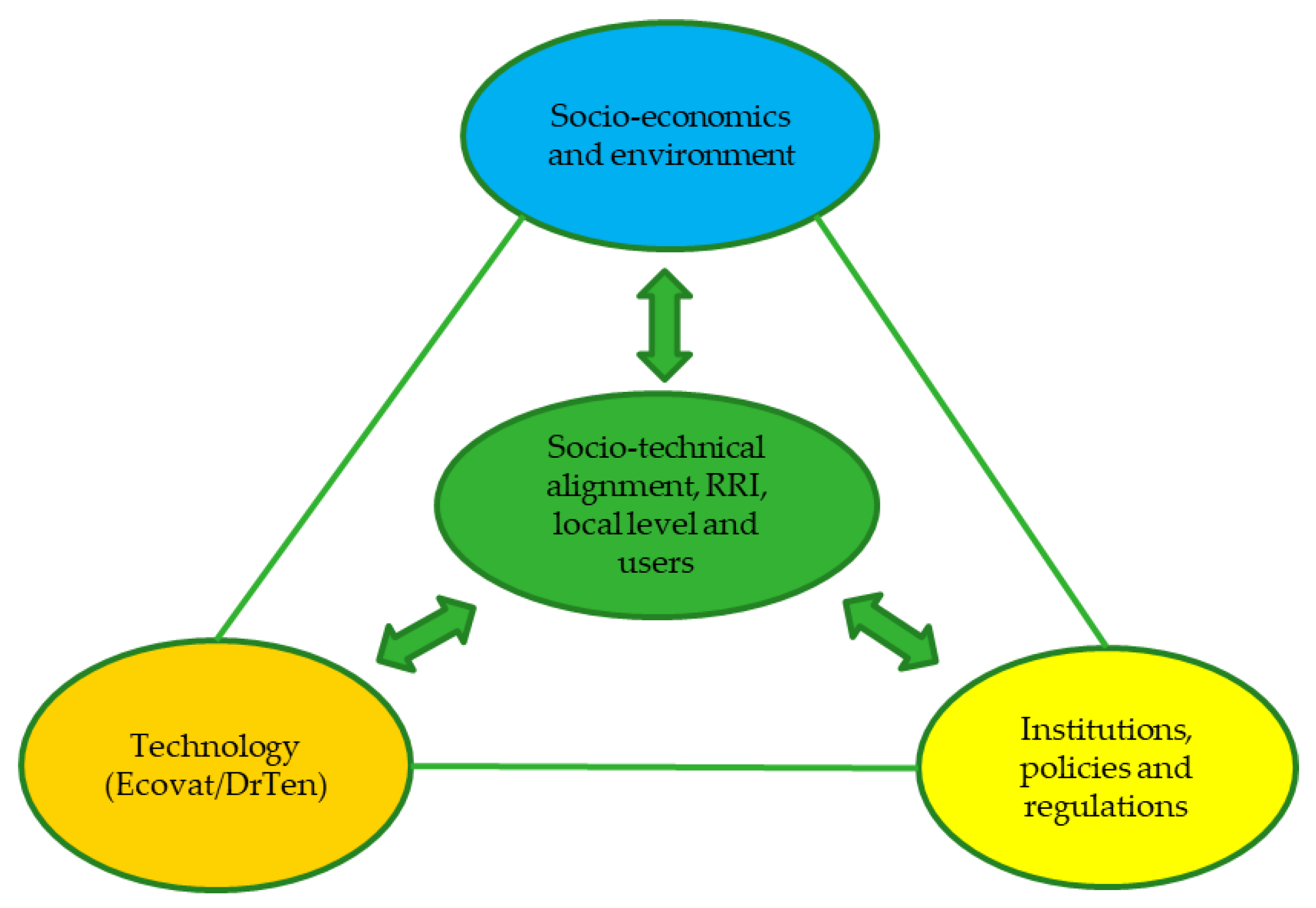
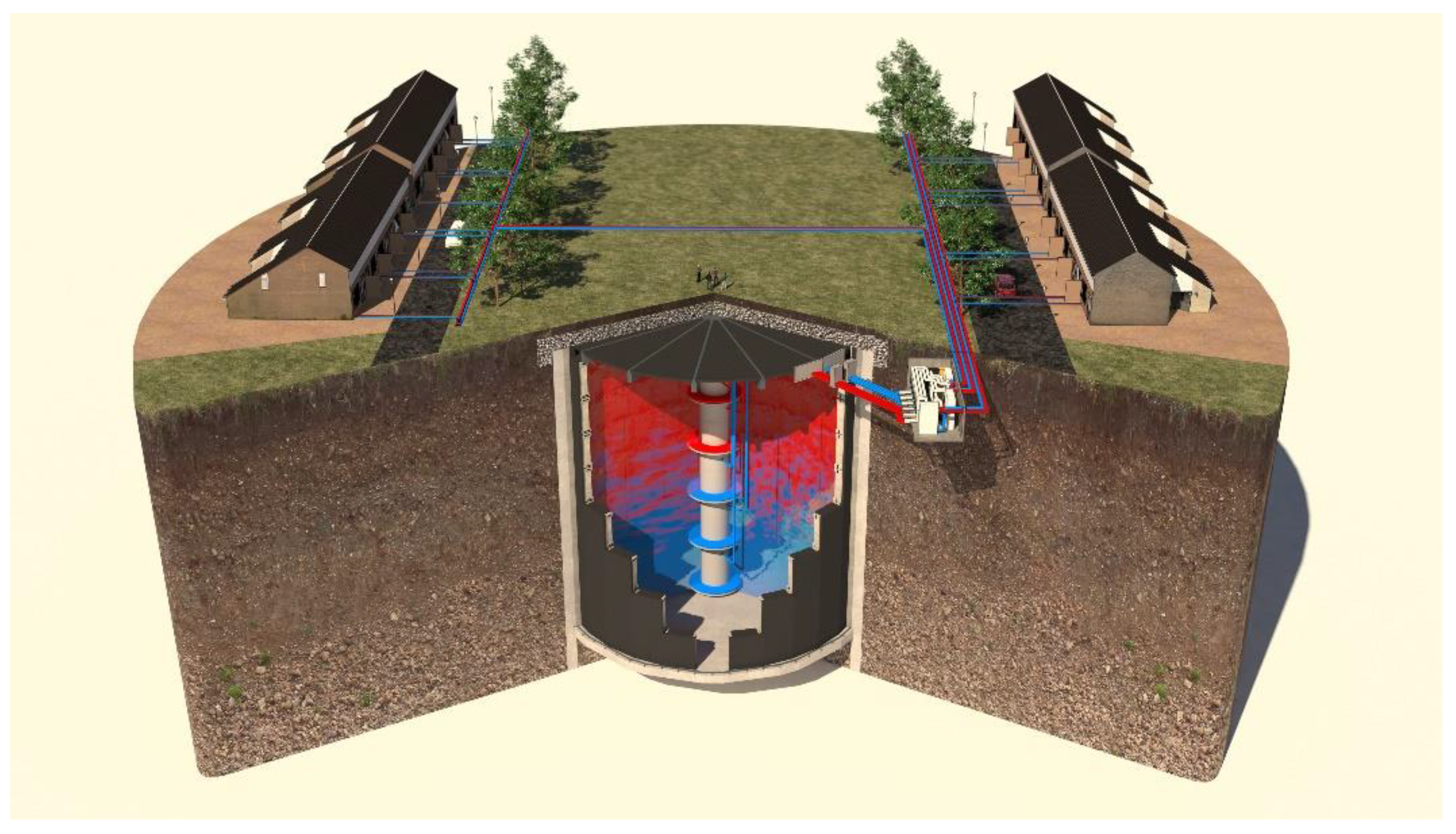
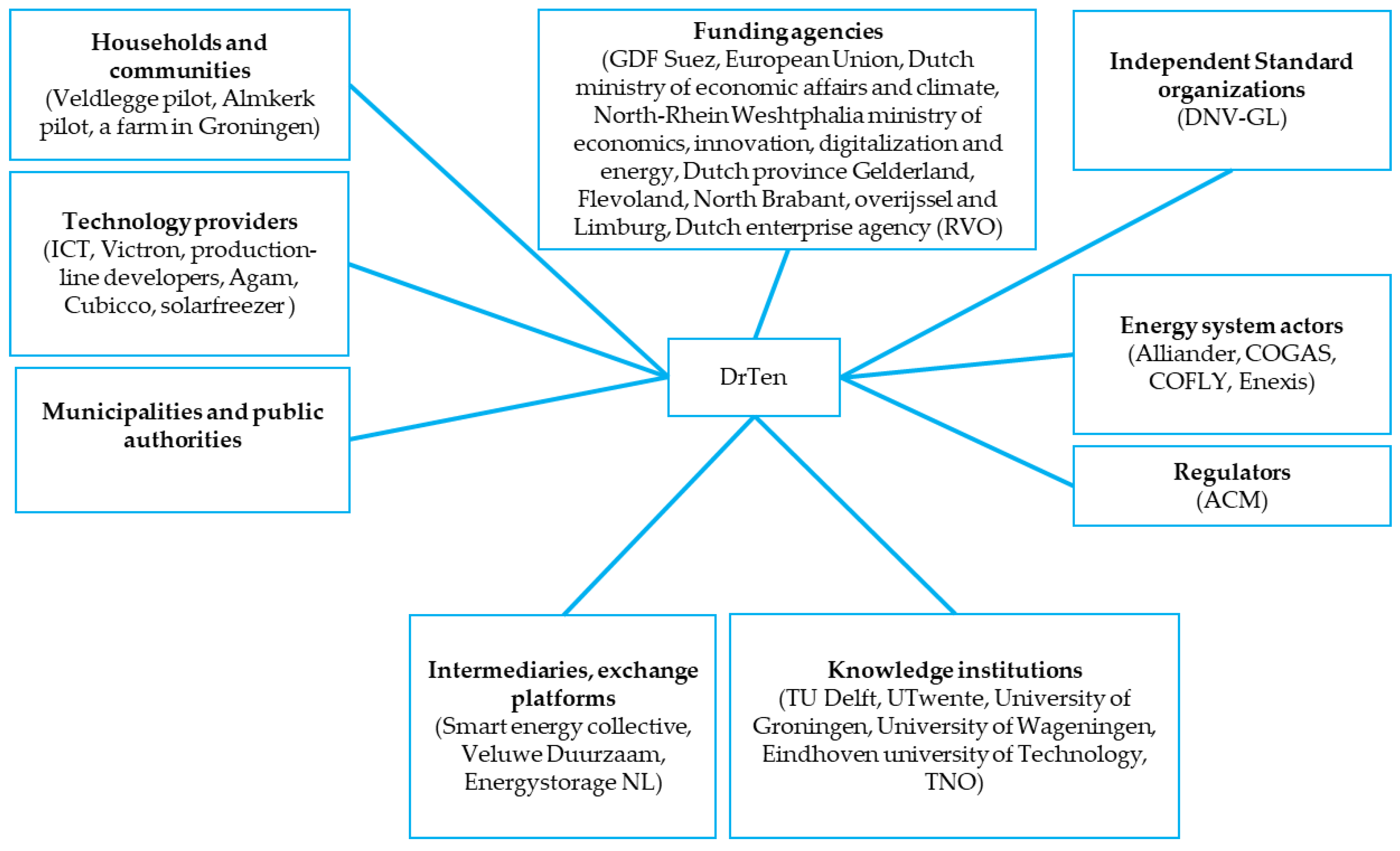
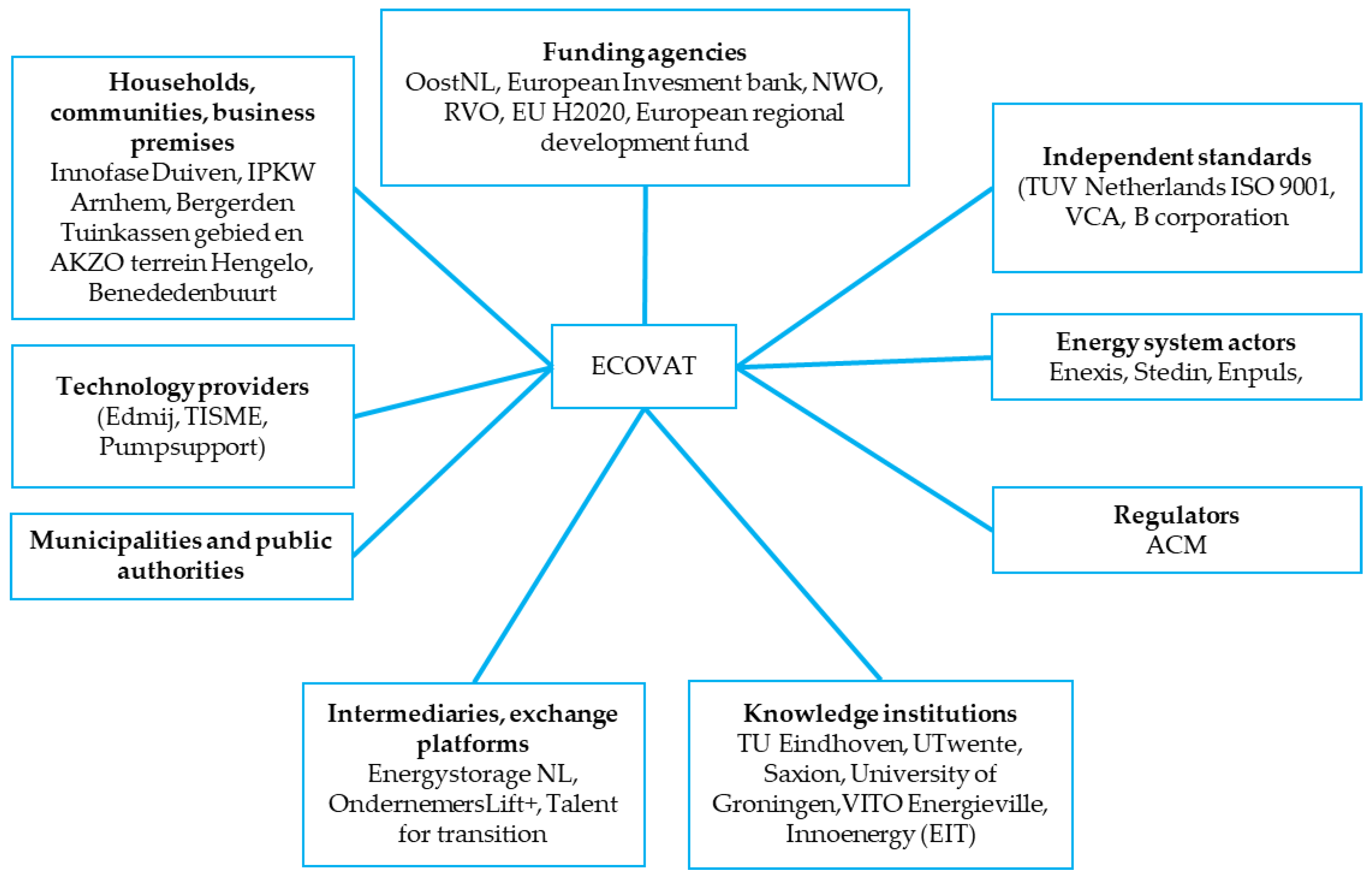
| Ecovat®(Benedenbuurt) | DrTen®(Heeten) | |
|---|---|---|
| Initiators | Charismatic, creative idealist (resident) (heteregoneous citizens) | Combination of smart strategist (Escozon) and charismatic resident (Endona) (heterogeneous citizens) |
| Stakeholders/organisation | Only local stakeholders, little involvement of traditional energy regime actors | Involvement of combination of local stakeholders and energy regime actors |
| Organisation/problem definitions | Fuzziness regarding who is responsible, inequalities of paid and volunteer workers, ad hoc incidental yet successful financing/problem definitions shift easily | Different roles are clear, All projects participants and materials are financed. Much alignment in problem definitions. |
| Involvement of users/residents | Users become more strongly organised during the process/now growing group of residents on drivers seat, discussions on ownership | Users/residents: very high participation but mainly in limited user role. More active contribution can grow in next phase of project |
| Tensions/conflicts | Between energy cooperative and interested commercial actors | DSO’s interest initially in conflict with vision of ‘net-zero behind the transformer’ |
| Material redefinitions | Reframing Ecovat® as logistic problem (number of trucks) | Battery safety was foregrounded/slow development of the linkage of seasalt battery to theICT system caused tension in the project but was improved later. |
© 2020 by the authors. Licensee MDPI, Basel, Switzerland. This article is an open access article distributed under the terms and conditions of the Creative Commons Attribution (CC BY) license (http://creativecommons.org/licenses/by/4.0/).
Share and Cite
Koirala, B.P.; van Oost, E.; van der Windt, H. Innovation Dynamics of Socio-Technical Alignment in Community Energy Storage: The Cases of DrTen and Ecovat. Energies 2020, 13, 2955. https://doi.org/10.3390/en13112955
Koirala BP, van Oost E, van der Windt H. Innovation Dynamics of Socio-Technical Alignment in Community Energy Storage: The Cases of DrTen and Ecovat. Energies. 2020; 13(11):2955. https://doi.org/10.3390/en13112955
Chicago/Turabian StyleKoirala, Binod Prasad, Ellen van Oost, and Henny van der Windt. 2020. "Innovation Dynamics of Socio-Technical Alignment in Community Energy Storage: The Cases of DrTen and Ecovat" Energies 13, no. 11: 2955. https://doi.org/10.3390/en13112955
APA StyleKoirala, B. P., van Oost, E., & van der Windt, H. (2020). Innovation Dynamics of Socio-Technical Alignment in Community Energy Storage: The Cases of DrTen and Ecovat. Energies, 13(11), 2955. https://doi.org/10.3390/en13112955






